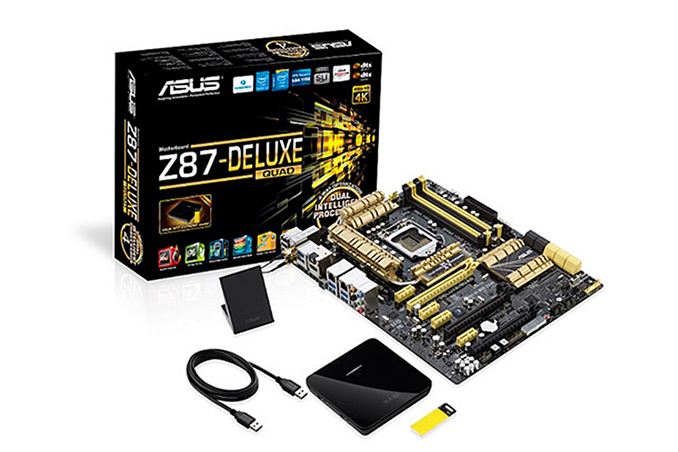ASUS Introduces Z87-Deluxe/Quad: World’s First Thunderbolt 2 Certified Motherboard
by Jarred Walton on August 19, 2013 9:55 PM EST- Posted in
- Motherboards
- Asus
- Thunderbolt
- 4K
- Z87
- Thunderbolt 2
- Falcon Ridge

For those that might not be too familiar with the standard, Thunderbolt is Intel’s high-bandwidth, do-everything connector, designed as a potential future path for all things external to a system—displays, USB devices, external storage, PCI Express, and even graphics cards. Thunderbolt supports up to 10Gb/s bandwidth (uni-directional) for each port, which is double what USB 3.0 offers, but the cost to implement Thunderbolt tends to be quite a bit higher than USB. For that reason, not to mention the ubiquity and backwards compatibility of USB 3.0 ports, we haven’t seen all that many Thunderbolt-equipped Windows laptops and motherboards; mostly the ports are found on higher-end motherboards.
For those that need high bandwidth access to external devices, however, even 10Gb/s may not be enough—specifically, 4K/60 video resolutions can require around 15Gb/s. As we’ve previously discussed, with Thunderbolt 2 Intel is doubling the bandwidth with Thunderbolt 2 up to 20Gb/s per port (bi-directional) by combining the four 10Gb/s channels into two 20Gb/s channels, thus enabling support for 4K/60 support. The ASUS Z87-Deluxe/Quad motherboard is the first motherboard to support the standard, and as expected you get two 20Gb/s ports courtesy of the single Falcon Ridge controller. Combined with the HDMI port, that gives the board the potential to drive three 4K displays at once. And if Thunderbolt 2 support isn’t enough for your enthusiast heart, ASUS is also including their NFC Express accessory for Near-Field Communication.
Here’s the short specifications summary for the Z87-Deluxe/Quad; we’re awaiting further details on expected availability and pricing, but given the Z87-Deluxe/Dual runs $350 we’d expect the new board to come in above that price point.
- 2 x Intel Thunderbolt 2 ports
- 1 x HDMI port
- 4 x DIMM slots
- 3 x PCIe 3.0/2.0 x16 slots
- 10 x SATA 6Gbit/s ports
- 8 x USB 3.0 ports with USB 3.0 Boost
- 8 x USB 2.0 ports
- ATX form factor
Source: ASUS Press Release










56 Comments
View All Comments
colonelclaw - Wednesday, August 21, 2013 - link
It's a bit of a shame that Thunderbolt has so far been slow to be adopted, breaking out PCIe to a cable makes a lot of sense for many situations. I guess it all comes down to cost? Here's hoping TB2 makes the difference.DanNeely - Wednesday, August 21, 2013 - link
Only putting a controller in their next south bridge might make a difference. If you define making a difference as adding more TB ports to computers, not getting more TB devices on the market. The other thing Intel should do if they want to promote TB is to up the number of PCIe lanes available; the situation has been squeezed since Intel dropped the legacy PCI controller's 4(?) connections but didn't add PCIe lanes to compensate. While OEMs can add a PLX to work around the problem that adds to costs and has a slight hit on performance; with PCIe-SSDs potentially becoming a major enthusiast item in a few years, walling off a lane or four for TB ports very few people will use isn't an appealing option.Hrel - Wednesday, August 21, 2013 - link
$350? Lol.thunderbolt is a great idea, but no one cares until motherboards with it are under $150.
Now, I'm an enthusiast so was willing to go around 200. But there's not a chance in hell I'd convince the corporation I work at to pay that much extra for something with such limited support.
If they're serious about Thunderbolt they have to give it away. Google knows this, you don't see them charging $soft money for Android. Because they know the way in which you penetrate a market is by giving your product away for free; the money comes later.
Such a simple idea that alludes so many.
solipsism - Thursday, August 22, 2013 - link
1) Do you realize you just said the key to running a for-profit business is to not charge a profit?2) Google's business is advertising. Search, email, Android, etc. are free because we're the product. We're the Eloi. Their customers are the ones paying for advertising or for info on herd's habits.
3) Also remember we're talking about SW v HW where your argument continues to fall apart.
thomasxstewart - Thursday, August 22, 2013 - link
tundra is good, yet in primary tests all 3 pci-e3 3 slot game card macines fluttered image. there are 4 slot pci-e3 mainboards, yet only 48 lane pci-e3, so two slots are 8x. ahso, claim for another 2x pci-e3 might bee stutter. basically with 64 pci-e3 lanes, might be god to go with thunderbolt advantage.drashek
ReneGQ - Thursday, March 13, 2014 - link
I recently purchased an Asus Motherboard and the problems started from day 1. The drivers update never works, the same for AI Suite III (there´s a lot of updates for this model in Asus webpage). After 2 months I still can´t install BitDefender cause a clock watchdog error.Asus technical support is the worst, mails comes and goes with no solution.
I will not recommend this brand to anyone. The brand has a very good Marketing but the product and the service are very disappointment.